ESP TOYOTA AYGO 2019 Owners Manual (in English)
[x] Cancel search | Manufacturer: TOYOTA, Model Year: 2019, Model line: AYGO, Model: TOYOTA AYGO 2019Pages: 504, PDF Size: 67.32 MB
Page 27 of 504
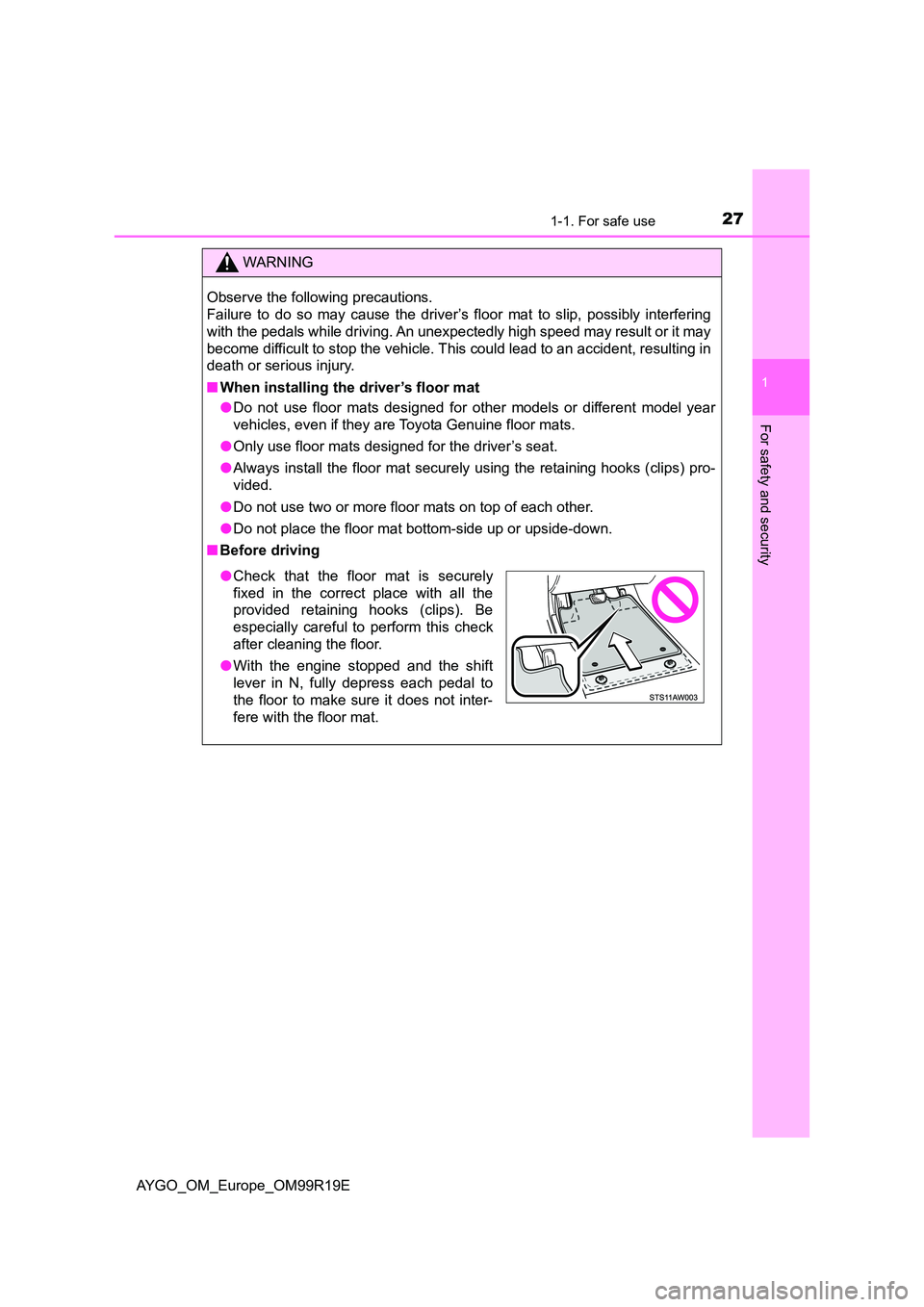
271-1. For safe use
1
For safety and security
AYGO_OM_Europe_OM99R19E
WARNING
Observe the following precautions.
Failure to do so may cause the driver’s floor mat to slip, possibly interfering
with the pedals while driving. An unexpectedly high speed may result or it may
become difficult to stop the vehicle. This could lead to an accident, resulting in
death or serious injury.
■ When installing the driver’s floor mat
● Do not use floor mats designed for other models or different model year
vehicles, even if they are Toyota Genuine floor mats.
● Only use floor mats designed for the driver’s seat.
● Always install the floor mat securely using the retaining hooks (clips) pro-
vided.
● Do not use two or more floor mats on top of each other.
● Do not place the floor mat bottom-side up or upside-down.
■ Before driving
●Check that the floor mat is securely
fixed in the correct place with all the
provided retaining hooks (clips). Be
especially careful to perform this check
after cleaning the floor.
● With the engine stopped and the shift
lever in N, fully depress each pedal to
the floor to make sure it does not inter-
fere with the floor mat.
Page 37 of 504
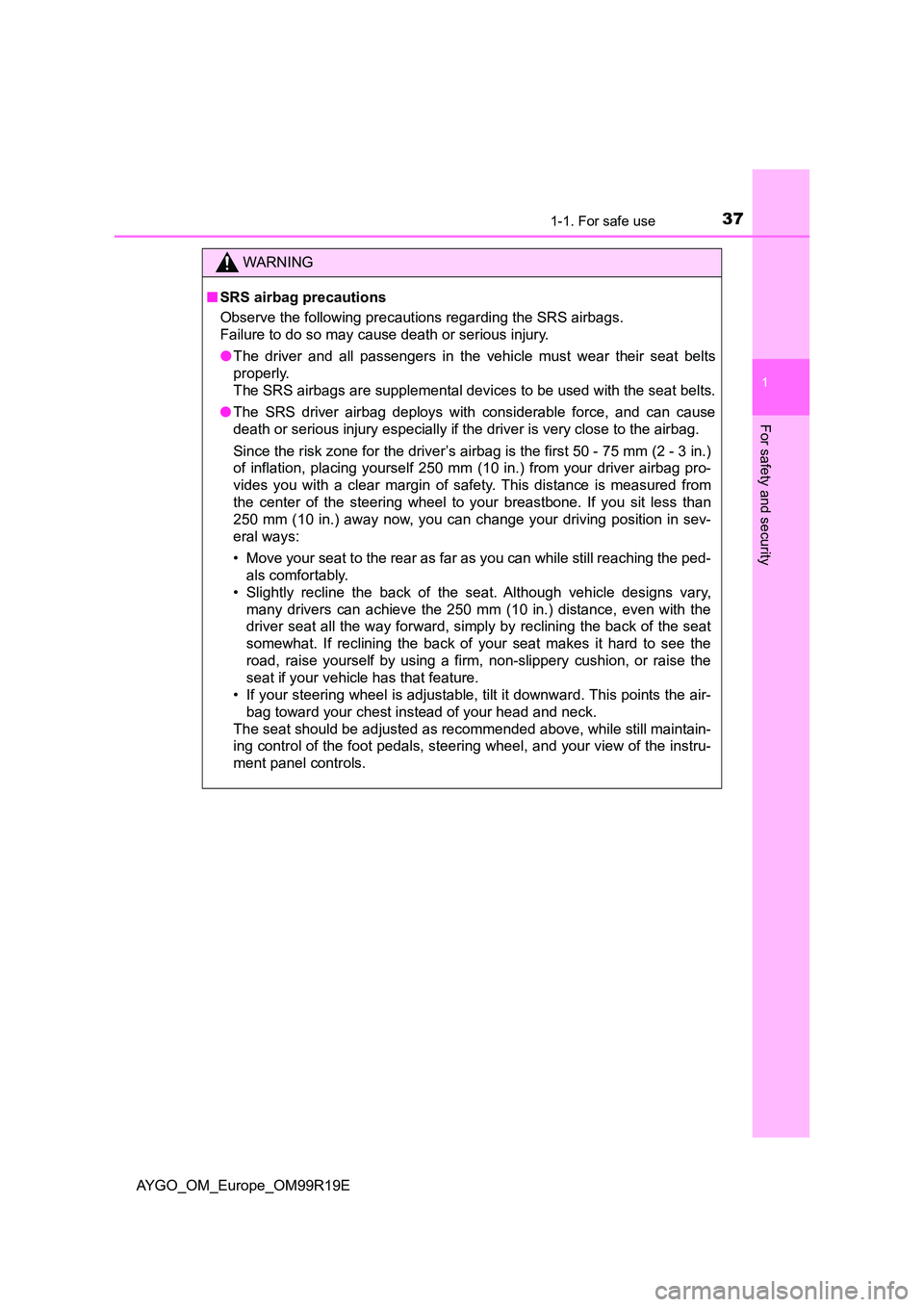
371-1. For safe use
1
For safety and security
AYGO_OM_Europe_OM99R19E
WARNING
■SRS airbag precautions
Observe the following precautions regarding the SRS airbags.
Failure to do so may cause death or serious injury.
● The driver and all passengers in the vehicle must wear their seat belts
properly.
The SRS airbags are supplemental devic es to be used with the seat belts.
● The SRS driver airbag deploys with considerable force, and can cause
death or serious injury especially if the driver is very close to the airbag.
Since the risk zone for the driver’s airbag is the first 50 - 75 mm (2 - 3 in.)
of inflation, placing yourself 250 mm ( 10 in.) from your driver airbag pro-
vides you with a clear margin of safety. This distance is measured from
the center of the steering wheel to your breastbone. If you sit less than
250 mm (10 in.) away now, you can change your driving position in sev-
eral ways:
• Move your seat to the rear as far as you can while still reaching the ped-
als comfortably.
• Slightly recline the back of the seat. Although vehicle designs vary,
many drivers can achieve the 250 mm (10 in.) distance, even with the
driver seat all the way forward, simply by reclining the back of the seat
somewhat. If reclining the back of your seat makes it hard to see the
road, raise yourself by using a firm, non-slippery cushion, or raise the
seat if your vehicle has that feature.
• If your steering wheel is adjustable, tilt it downward. This points the air-
bag toward your chest instead of your head and neck.
The seat should be adjusted as recommended above, while still maintain-
ing control of the foot pedals, steering wheel, and your view of the instru-
ment panel controls.
Page 38 of 504
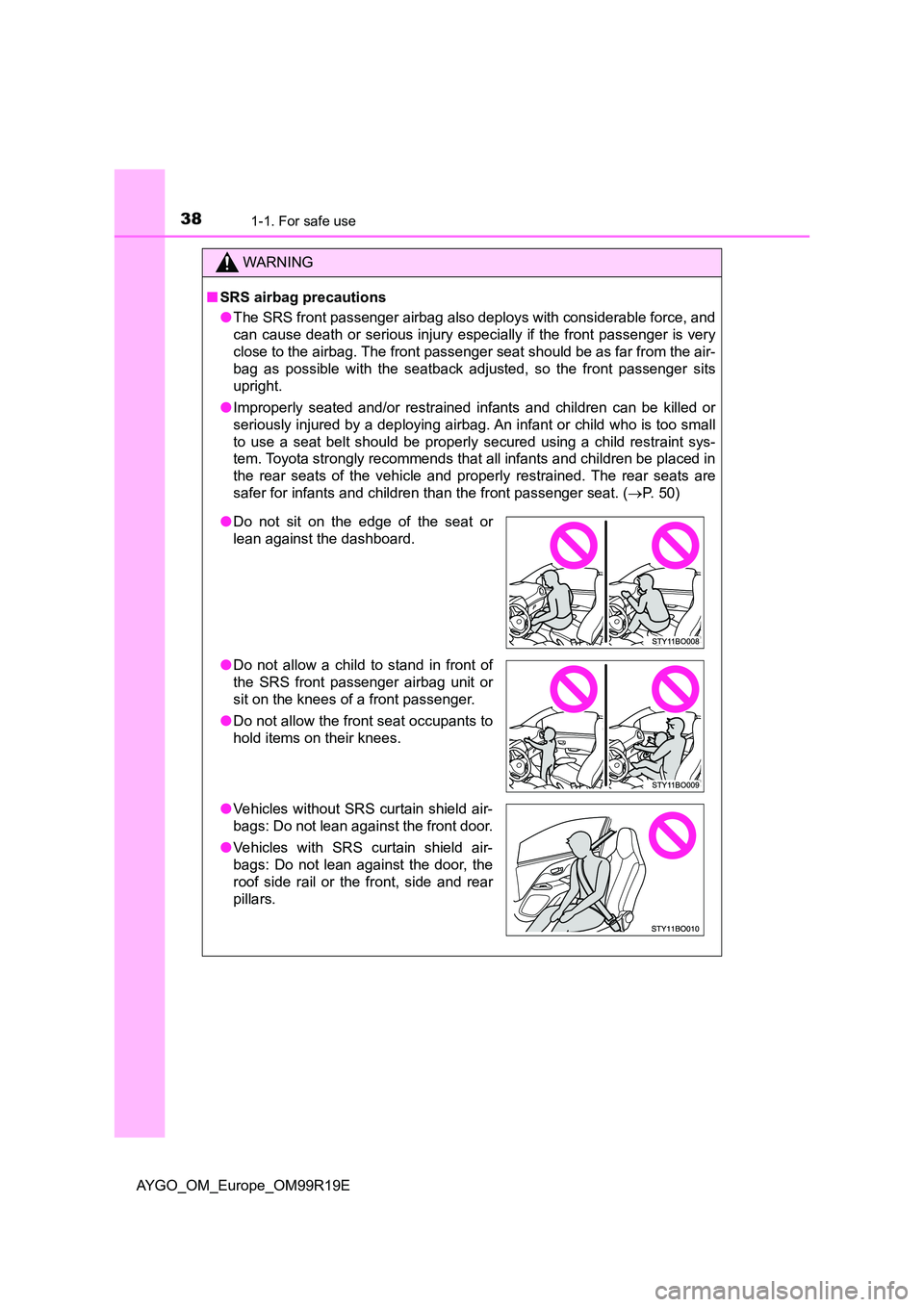
381-1. For safe use
AYGO_OM_Europe_OM99R19E
WARNING
■SRS airbag precautions
● The SRS front passenger airbag also deploys with considerable force, and
can cause death or serious injury especially if the front passenger is very
close to the airbag. The front passenger seat should be as far from the air-
bag as possible with the seatback adjusted, so the front passenger sits
upright.
● Improperly seated and/or restrained infants and children can be killed or
seriously injured by a deploying airbag. An infant or child who is too small
to use a seat belt should be properly secured using a child restraint sys-
tem. Toyota strongly recommends that all infants and children be placed in
the rear seats of the vehicle and proper ly restrained. The rear seats are
safer for infants and children than the front passenger seat. ( P. 50)
●Do not sit on the edge of the seat or
lean against the dashboard.
● Do not allow a child to stand in front of
the SRS front passenger airbag unit or
sit on the knees of a front passenger.
● Do not allow the front seat occupants to
hold items on their knees.
● Vehicles without SRS curtain shield air-
bags: Do not lean against the front door.
● Vehicles with SRS curtain shield air-
bags: Do not lean against the door, the
roof side rail or the front, side and rear
pillars.
Page 41 of 504
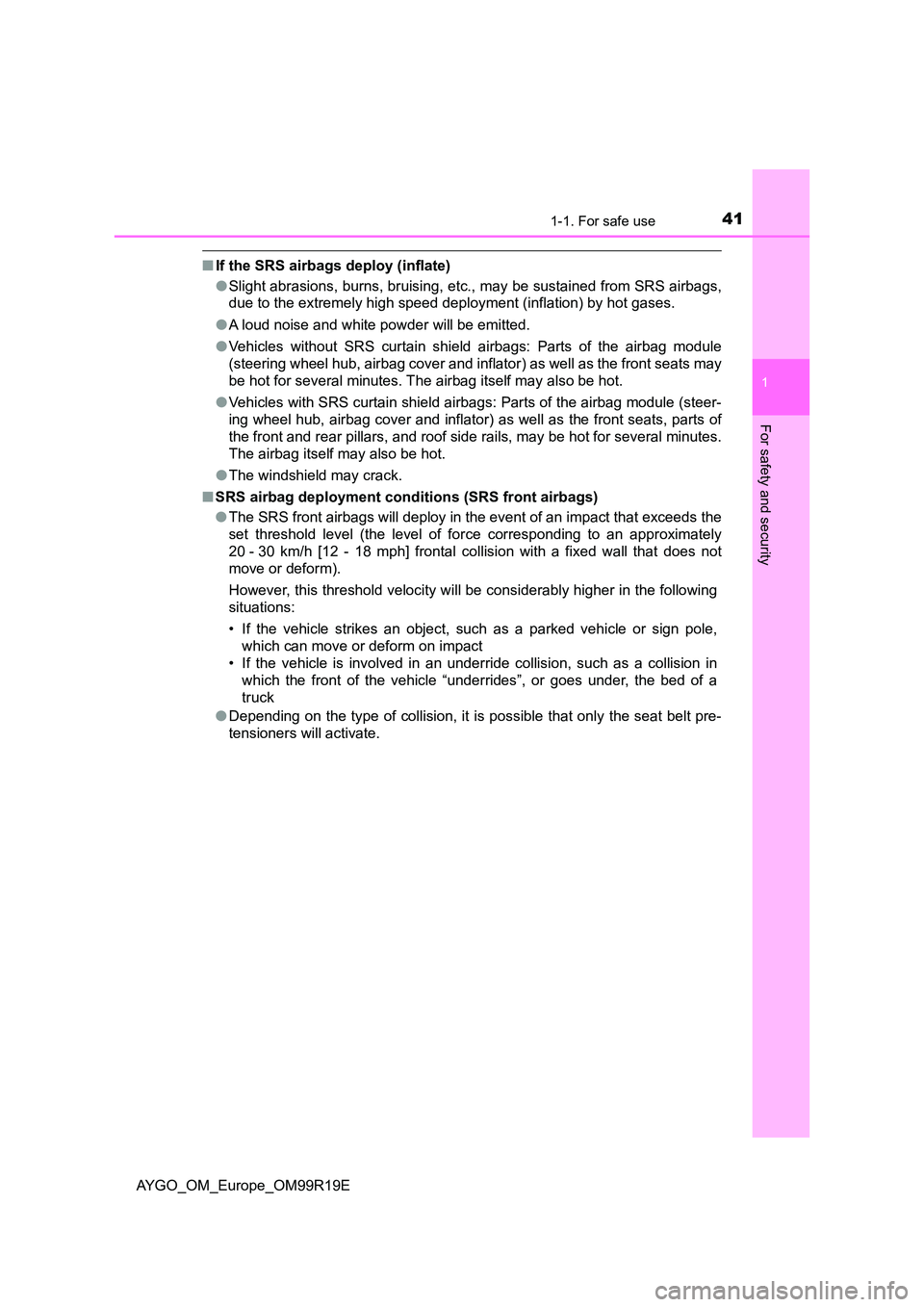
411-1. For safe use
1
For safety and security
AYGO_OM_Europe_OM99R19E
■If the SRS airbags deploy (inflate)
● Slight abrasions, burns, bruising, etc., may be sustained from SRS airbags,
due to the extremely high speed deployment (inflation) by hot gases.
● A loud noise and white powder will be emitted.
● Vehicles without SRS curtain shield airbags: Parts of the airbag module
(steering wheel hub, airbag cover and inflator) as well as the front seats may
be hot for several minutes. The airbag itself may also be hot.
● Vehicles with SRS curtain shield airbags: Parts of the airbag module (steer-
ing wheel hub, airbag cover and inflator) as well as the front seats, parts of
the front and rear pillars, and roof side rails, may be hot for several minutes.
The airbag itself may also be hot.
● The windshield may crack.
■ SRS airbag deployment conditions (SRS front airbags)
● The SRS front airbags will deploy in the event of an impact that exceeds the
set threshold level (the level of force corresponding to an approximately
20 - 30 km/h [12 - 18 mph] frontal collision with a fixed wall that does not
move or deform).
However, this threshold velocity will be considerably higher in the following
situations:
• If the vehicle strikes an object, such as a parked vehicle or sign pole,
which can move or deform on impact
• If the vehicle is involved in an underride collision, such as a collision in
which the front of the vehicle “underrides”, or goes under, the bed of a
truck
● Depending on the type of collision, it is possible that only the seat belt pre-
tensioners will activate.
Page 42 of 504
![TOYOTA AYGO 2019 Owners Manual (in English) 421-1. For safe use
AYGO_OM_Europe_OM99R19E
■ SRS airbag deployment conditions (SRS side airbags and SRS curtain
shield airbags [if equipped])
● The SRS side airbags and SRS curtain shield airb TOYOTA AYGO 2019 Owners Manual (in English) 421-1. For safe use
AYGO_OM_Europe_OM99R19E
■ SRS airbag deployment conditions (SRS side airbags and SRS curtain
shield airbags [if equipped])
● The SRS side airbags and SRS curtain shield airb](/img/14/48450/w960_48450-41.png)
421-1. For safe use
AYGO_OM_Europe_OM99R19E
■ SRS airbag deployment conditions (SRS side airbags and SRS curtain
shield airbags [if equipped])
● The SRS side airbags and SRS curtain shield airbags (if equipped) will
deploy in the event of an impact that exceeds the set threshold level (the
level of force corresponding to the impact force produced by an approxi-
mately 1500 kg [3300 lb.] vehicle colliding with the vehicle cabin from a
direction perpendicular to the vehicle orientation at an approximate speed of
20 - 30 km/h [12 - 18 mph]).
● Both SRS curtain shield airbags (if equipped) may also deploy in the event
of a severe frontal collision.
■ Conditions under which the SRS airbags may deploy (inflate), other than
a collision
The SRS front airbags and SRS curtain shield airbags (if equipped) may also
deploy if a serious impact occurs to the underside of your vehicle. Some
examples are shown in the illustration.
■ Types of collisions that may not deploy the SRS airbags (SRS front air-
bags)
The SRS front airbags do not generally infl ate if the vehicle is involved in a
side or rear collision, if it rolls over, or if it is involved in a low-speed frontal
collision. But, whenever a collision of any type causes sufficient forward
deceleration of the vehicle, deployment of the SRS front airbags may occur.
● Hitting a curb, edge of pavement or hard
surface
● Falling into or jumping over a deep hole
● Landing hard or falling
● Collision from the side
● Collision from the rear
● Vehicle rollover
Page 60 of 504
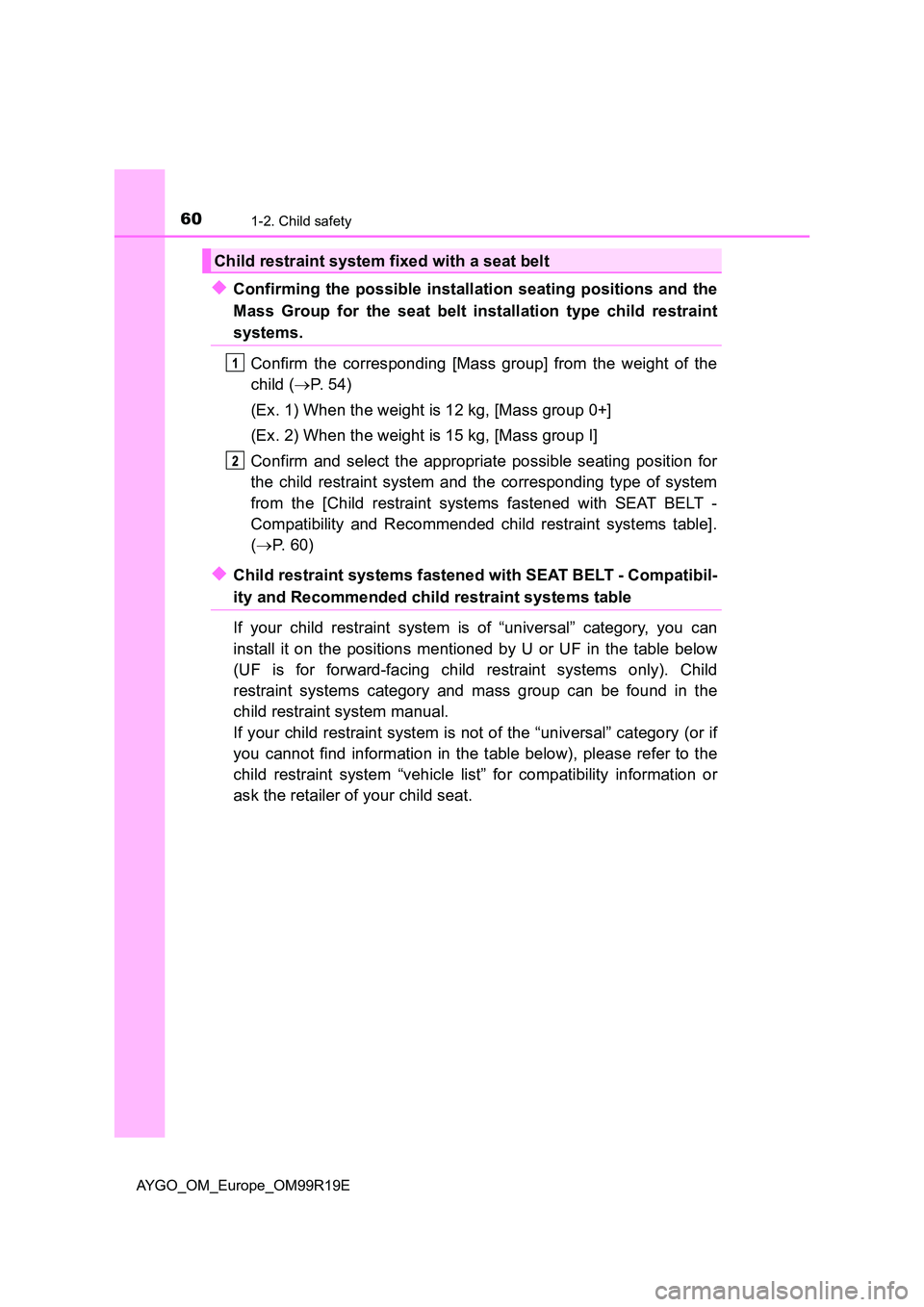
601-2. Child safety
AYGO_OM_Europe_OM99R19E
◆Confirming the possible installation seating positions and the
Mass Group for the seat belt installation type child restraint
systems.
Confirm the corresponding [Mass group] from the weight of the
child ( P. 54)
(Ex. 1) When the weight is 12 kg, [Mass group 0+]
(Ex. 2) When the weight is 15 kg, [Mass group I]
Confirm and select the appropriate possible seating position for
the child restraint system and the corresponding type of system
from the [Child restraint systems fastened with SEAT BELT -
Compatibility and Recommended child restraint systems table].
( P. 6 0 )
◆Child restraint systems fastened with SEAT BELT - Compatibil-
ity and Recommended child restraint systems table
If your child restraint system is of “universal” category, you can
install it on the positions mentioned by U or UF in the table below
(UF is for forward-facing child restraint systems only). Child
restraint systems category and mass group can be found in the
child restraint system manual.
If your child restraint system is not of the “universal” category (or if
you cannot find information in the table below), please refer to the
child restraint system “vehicle list” for compatibility information or
ask the retailer of your child seat.
Child restraint system fixed with a seat belt
Page 67 of 504
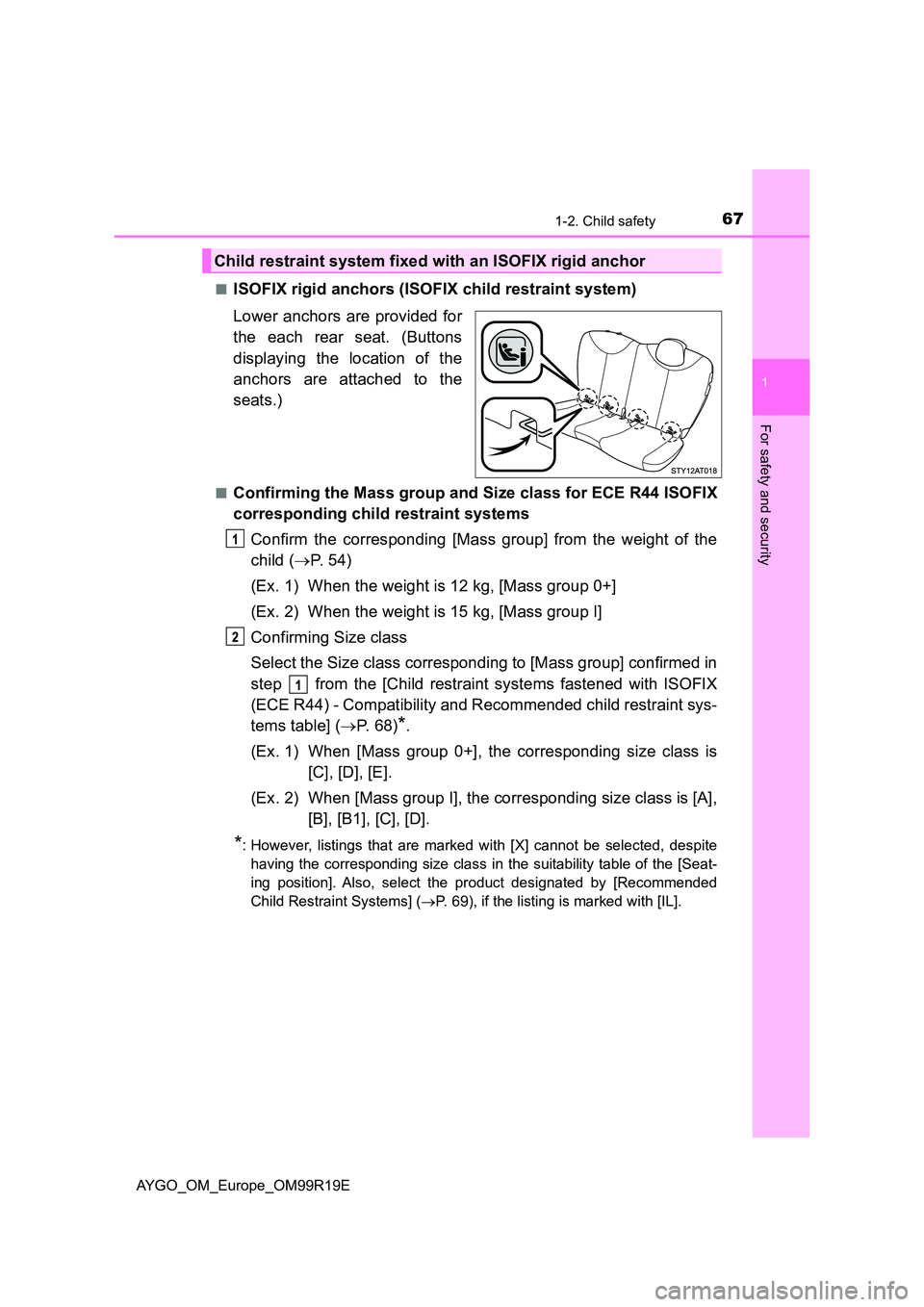
671-2. Child safety
1
For safety and security
AYGO_OM_Europe_OM99R19E
■ISOFIX rigid anchors (ISOFIX child restraint system)
Lower anchors are provided for
the each rear seat. (Buttons
displaying the location of the
anchors are attached to the
seats.)
■Confirming the Mass group and Size class for ECE R44 ISOFIX
corresponding child restraint systems
Confirm the corresponding [Mass group] from the weight of the
child ( P. 54)
(Ex. 1) When the weight is 12 kg, [Mass group 0+]
(Ex. 2) When the weight is 15 kg, [Mass group I]
Confirming Size class
Select the Size class corresponding to [Mass group] confirmed in
step from the [Child restraint systems fastened with ISOFIX
(ECE R44) - Compatibility and Recommended child restraint sys-
tems table] ( P. 68)*.
(Ex. 1) When [Mass group 0+], the corresponding size class is
[C], [D], [E].
(Ex. 2) When [Mass group I], the corresponding size class is [A],
[B], [B1], [C], [D].
*: However, listings that are marked with [X] cannot be selected, despite
having the corresponding size class in the suitability table of the [Seat-
ing position]. Also, select the product designated by [Recommended
Child Restraint Systems] ( P. 69), if the listing is marked with [IL].
Child restraint system fixed with an ISOFIX rigid anchor
Page 107 of 504
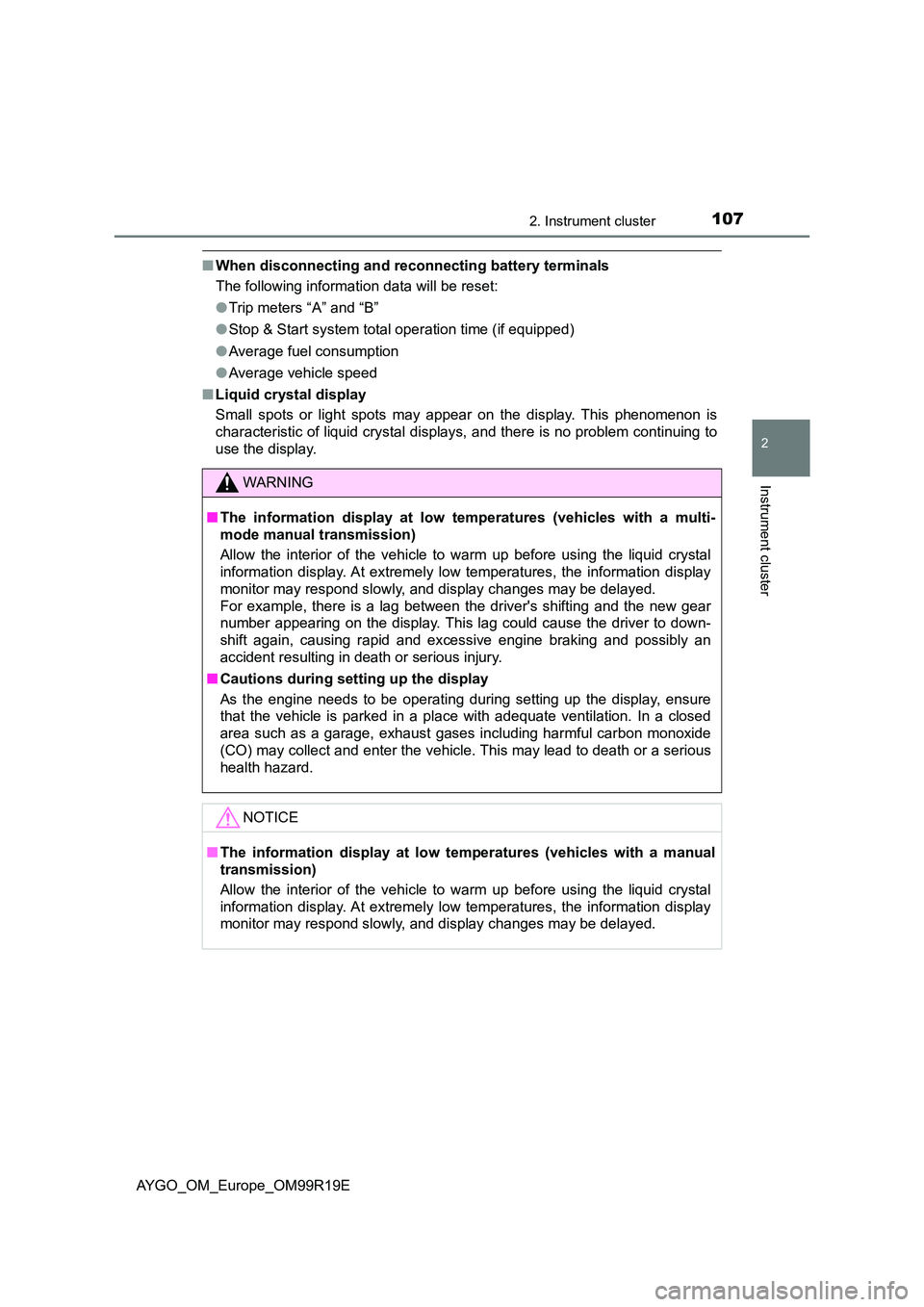
1072. Instrument cluster
2
Instrument cluster
AYGO_OM_Europe_OM99R19E
■When disconnecting and reconnecting battery terminals
The following information data will be reset:
● Trip meters “A” and “B”
● Stop & Start system total operation time (if equipped)
● Average fuel consumption
● Average vehicle speed
■ Liquid crystal display
Small spots or light spots may appear on the display. This phenomenon is
characteristic of liquid crystal displays, and there is no problem continuing to
use the display.
WARNING
■ The information display at low temperatures (vehicles with a multi-
mode manual transmission)
Allow the interior of the vehicle to warm up before using the liquid crystal
information display. At extremely low temperatures, the information display
monitor may respond slowly, and display changes may be delayed.
For example, there is a lag between the driver's shifting and the new gear
number appearing on the display. This lag could cause the driver to down-
shift again, causing rapid and exce ssive engine braking and possibly an
accident resulting in death or serious injury.
■ Cautions during setting up the display
As the engine needs to be operating during setting up the display, ensure
that the vehicle is parked in a place with adequate ventilation. In a closed
area such as a garage, exhaust gases including harmful carbon monoxide
(CO) may collect and enter the vehicle. This may lead to death or a serious
health hazard.
NOTICE
■ The information display at low temperatures (vehicles with a manual
transmission)
Allow the interior of the vehicle to warm up before using the liquid crystal
information display. At extremely low temperatures, the information display
monitor may respond slowly, and display changes may be delayed.
Page 122 of 504
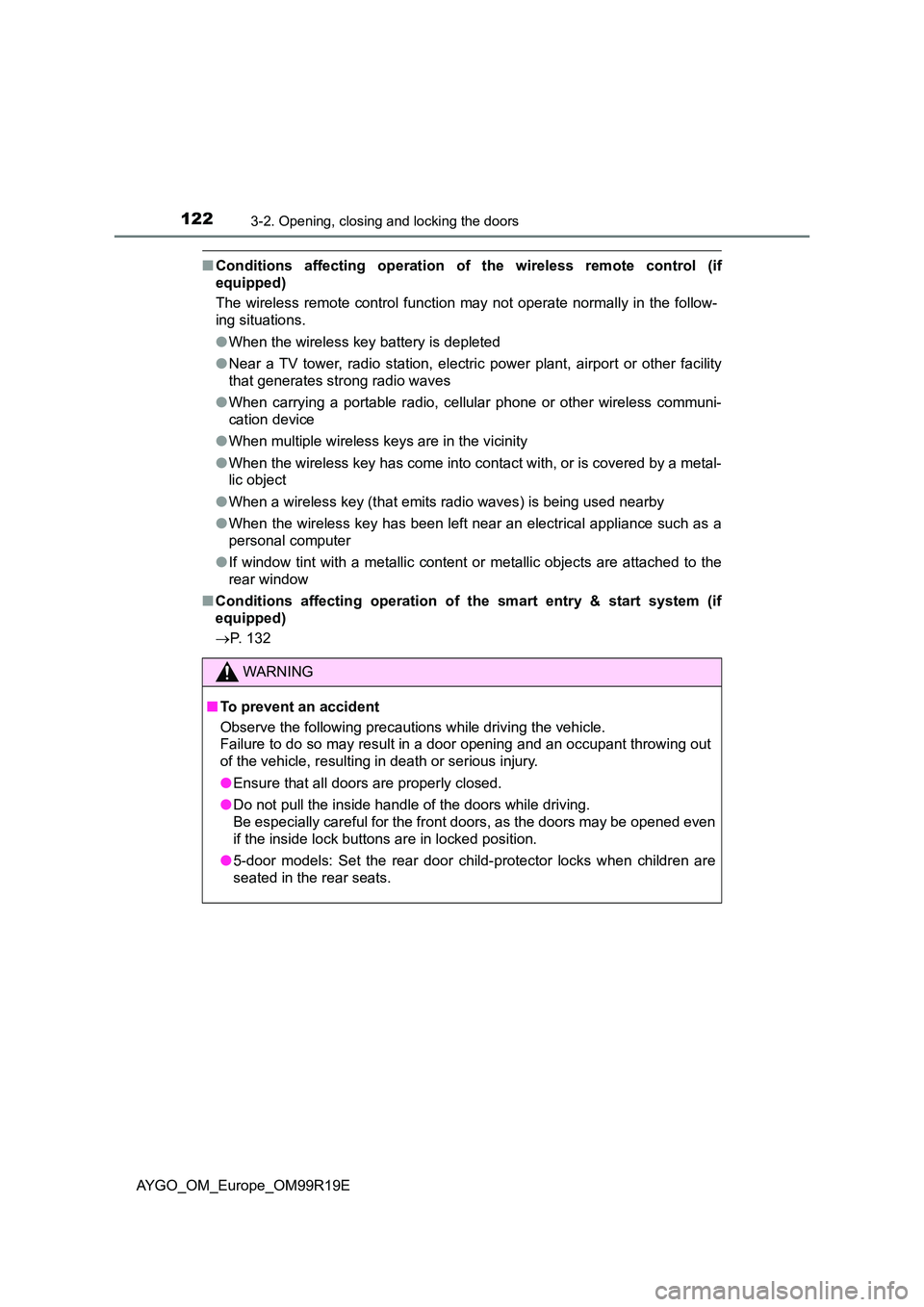
1223-2. Opening, closing and locking the doors
AYGO_OM_Europe_OM99R19E
■Conditions affecting operation of the wireless remote control (if
equipped)
The wireless remote control function may not operate normally in the follow-
ing situations.
● When the wireless key battery is depleted
● Near a TV tower, radio station, electric power plant, airport or other facility
that generates strong radio waves
● When carrying a portable radio, cellular phone or other wireless communi-
cation device
● When multiple wireless keys are in the vicinity
● When the wireless key has come into contact with, or is covered by a metal-
lic object
● When a wireless key (that emits radio waves) is being used nearby
● When the wireless key has been left near an electrical appliance such as a
personal computer
● If window tint with a metallic content or metallic objects are attached to the
rear window
■ Conditions affecting operation of the smart entry & start system (if
equipped)
P. 132
WARNING
■To prevent an accident
Observe the following precautions while driving the vehicle.
Failure to do so may result in a door opening and an occupant throwing out
of the vehicle, resulting in death or serious injury.
● Ensure that all doors are properly closed.
● Do not pull the inside handle of the doors while driving.
Be especially careful for the front doors, as the doors may be opened even
if the inside lock buttons are in locked position.
● 5-door models: Set the rear door child-protector locks when children are
seated in the rear seats.
Page 157 of 504
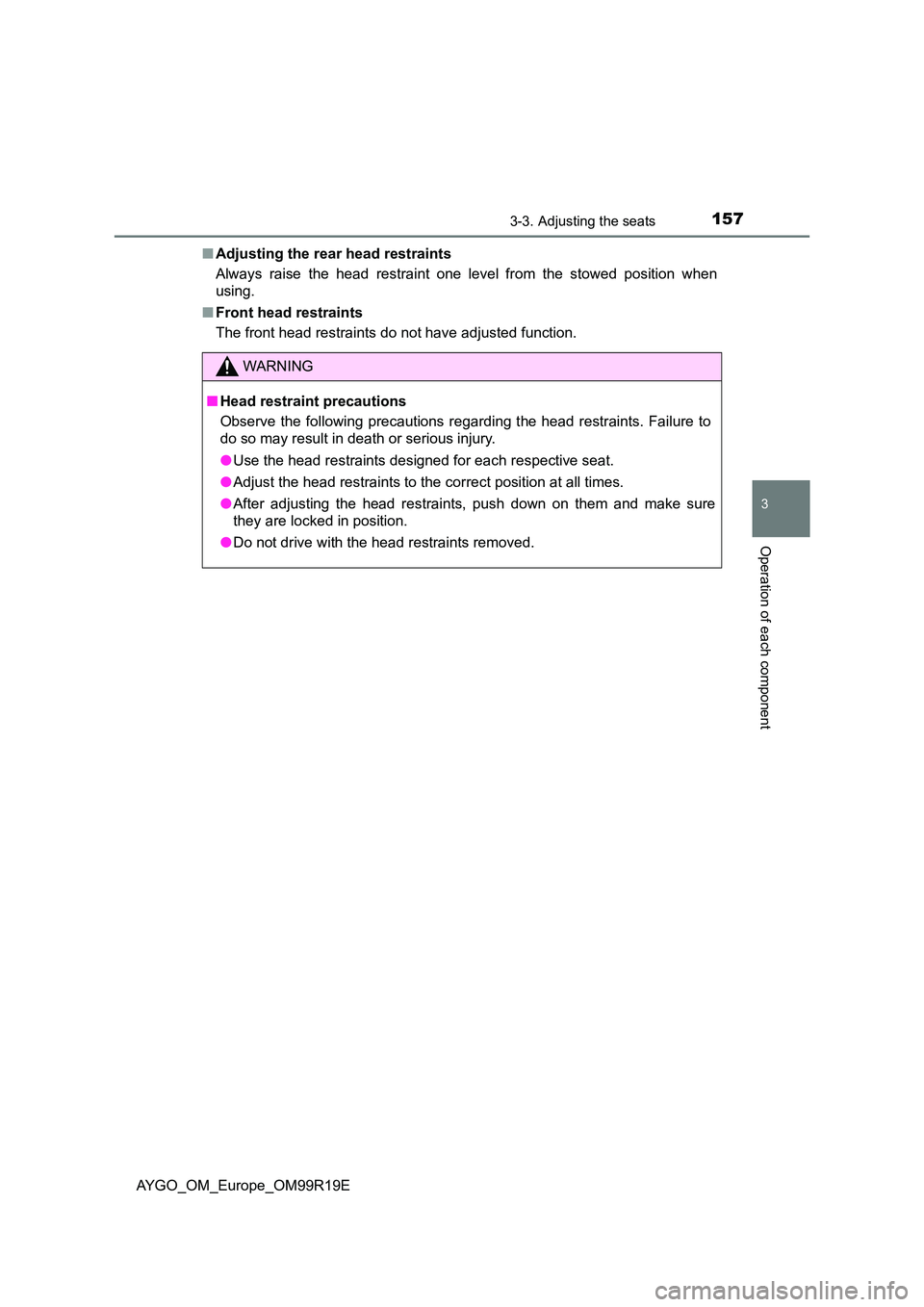
1573-3. Adjusting the seats
3
Operation of each component
AYGO_OM_Europe_OM99R19E
■ Adjusting the rear head restraints
Always raise the head restraint one level from the stowed position when
using.
■ Front head restraints
The front head restraints do not have adjusted function.
WARNING
■ Head restraint precautions
Observe the following precautions regarding the head restraints. Failure to
do so may result in death or serious injury.
● Use the head restraints designed for each respective seat.
● Adjust the head restraints to the correct position at all times.
● After adjusting the head restraints, push down on them and make sure
they are locked in position.
● Do not drive with the head restraints removed.